Most visitors to the Jaco area head to the beach for sun or surf. But for those interested in experiencing a taste of the culture, there’s a wonderful chocolate tour nearby. La Mona Golosa is a little-known cacao farm in the countryside outside Jaco. Our family recently visited and got to experience the tour and check out the property. In this post, we’ll tell you all about it and how you can plan a visit too.
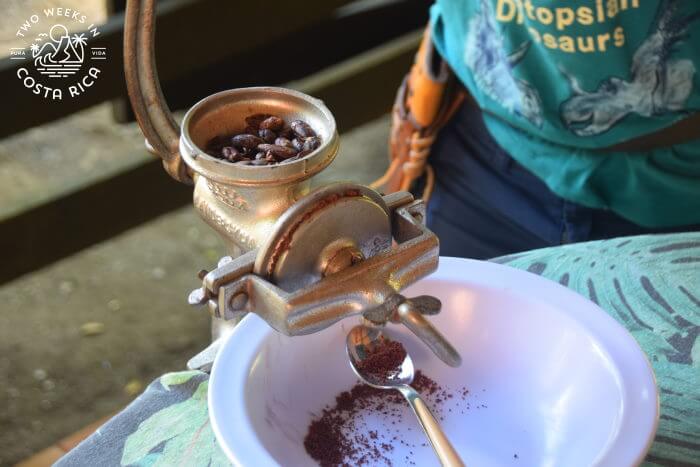
Background
Location
La Mona Golosa is a working cacao farm about 35 minutes from Jaco, far removed from the hustle and bustle of the main strip.
The vast farm is near the small community of Quebrada Amarilla. Surrounded by a mix of open fields, farmland, and forest, La Mona Golosa will show you a side of Costa Rica you can’t experience just staying in downtown Jaco. The setting is peaceful and serene, with thick rainforest all around and little development.
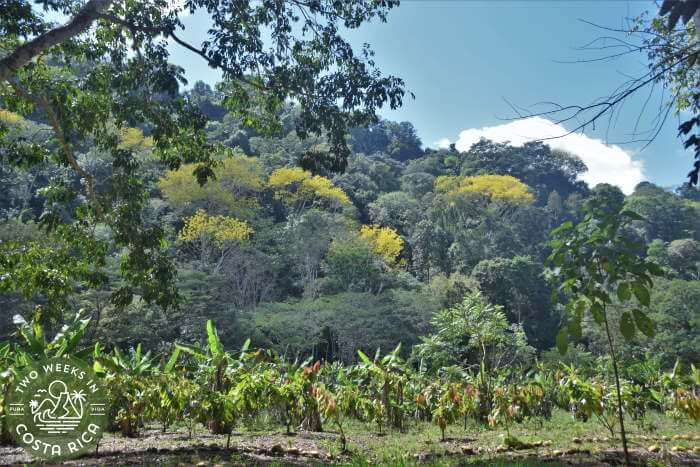
About the Farm
La Mona Golosa started as a regular farm. Much of the land was used for pasture for cows, which is typical of many farms in Costa Rica.
In 2008, an Italian family purchased the property. They wanted a way to eat healthy chocolate without chemicals or artificial additives like you find in commercial chocolate. So they soon started transitioning the land for sustainable cacao production.

Little by little, they grew the plantation. Today, La Mona Golosa has over 7,000 native cacao plants spread out over 13 hectares (32 acres).
Even with so many plants, their cacao production isn’t very high.
Interestingly, this is because of monkeys!
They estimate that monkeys take about 40% of their crop each year to eat. They have tried many different things to keep the monkeys away, but nothing has worked well. So they have resorted to just planting more cacao.
The name of the farm, La Mona Golosa, fittingly translates to “The Greedy Monkey.”
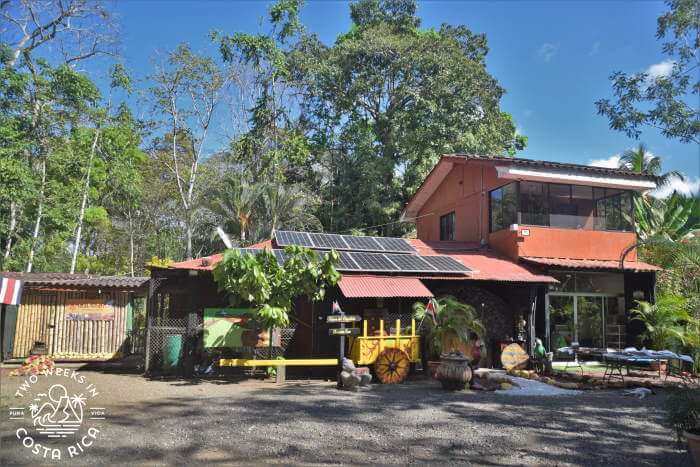
La Mona Golosa Chocolate Tour
Maya House and Cacao Ceremony
Our tour began with meeting our friendly guide, Diego, a local from the Jaco area. He started with a quick explanation about the farm then led us down a path beside the cacao fields.
Soon we came upon a large thatched-roof structure. Diego told us this was a replica of a traditional indigenous house.
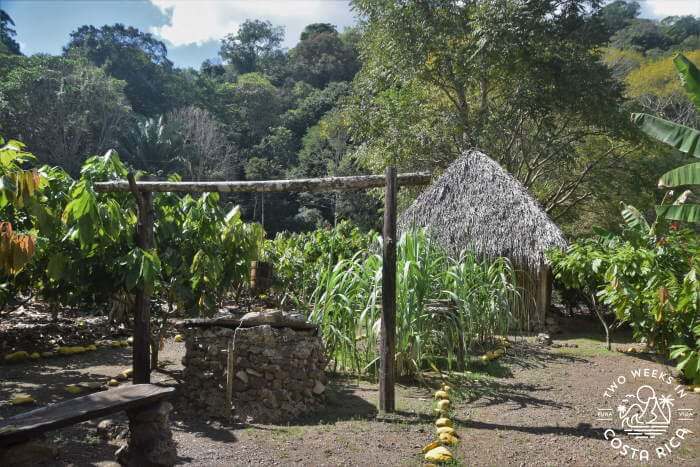
Indigenous people in Costa Rica lived in structures similar to this. Although the building was almost completely closed up, it was cool compared to the hot weather outside. Diego explained that this was due to the tall ceilings, a clever design used to let the heat escape.
Diego began explaining about the significance of cacao to indigenous people. He invited us to take part in a cacao ceremony.
We each took a small cup filled with hot water and pure cacao. They had also mixed in some salt, honey, and a bit of chili to make it more palatable. The salt and chili were added to take away the bitterness of the pure chocolate. This “Drink of the Gods” was actually quite tasty, though our two young boys weren’t so sure.
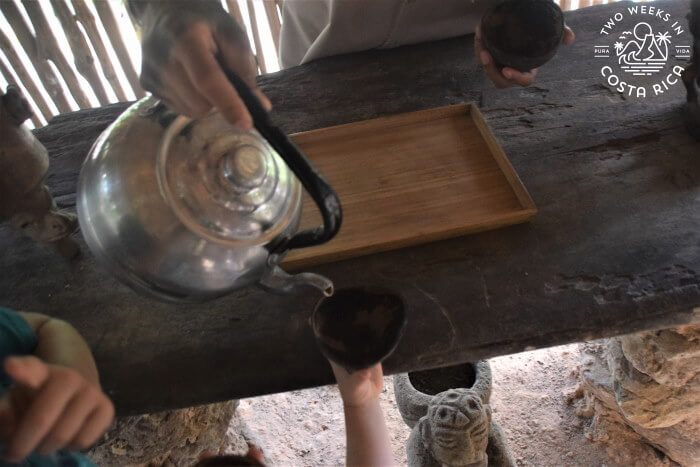
Diego went on to explain that this sacred drink was only served to royalty in indigenous times. It was said to connect their souls to the universe and nature.
Walking the Cacao Fields
After the cacao ceremony, we followed Diego into the fields. We explored only a small patch of the farm compared to the vast land we had seen from the road.
Diego showed us a cacao pod and helped us understand how long it takes for a cacao plant to produce a mature pod.
Astoundingly, we learned that it took 3-3.5 years from baby tree to flower.
Finding a small yellow flower, the guide then showed us the tiny baby fruit inside. It was barely visible with the naked eye.
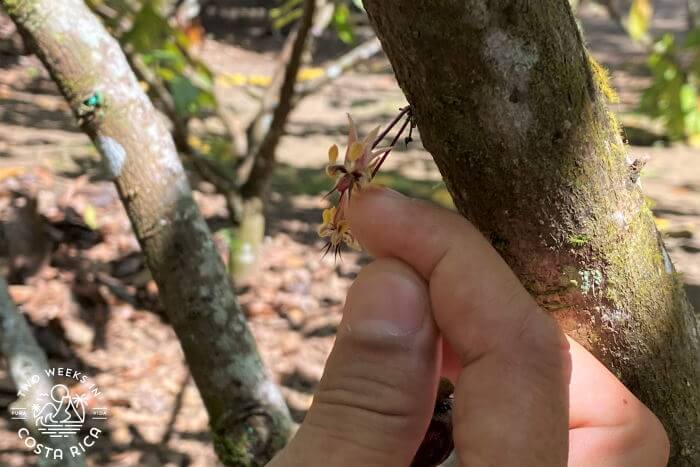
From flower to ripe fruit would take an additional 8-9 months, about the same amount of time as a human pregnancy.
Diego then invited our son to help open a pod. After hitting it a few times against a rock, the pod cracked open, revealing the rows of large white seeds inside.
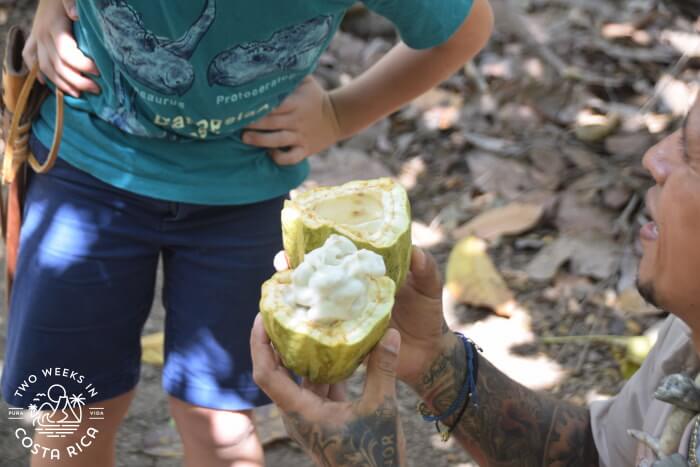
Most people don’t realize it but cacao straight from the pod tastes like fruit. Each seed has a slimy white covering that you can suck off and eat. The favor is similar to pineapple or banana, and is very sweet (hence why the monkeys like it). Diego invited each of us to try it.
Fermentation and Drying
From the cacao fields, we visited the fermentation room.
After the cacao seeds are removed from the pods, they are brought to this dark building where they sit covered in wooden containers to let the natural sugars ferment. This process helps elevate the nutrients in the chocolate.
In 5-7 days, the seeds turn brown. They are then dried naturally in the sun for another 5-7 days, or longer if it is rainy. This is the stage where they get that familiar color and start to look like chocolate.
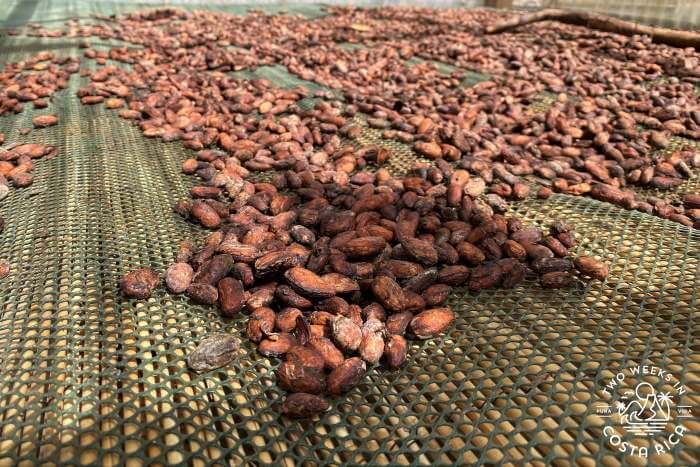
Roasting and Grinding
Once dried, Diego told us that the seeds are roasted and ground with modern machines. We weren’t able to go into the room where the family does these final steps but observed it from the outside.
We were, however, able to do our own roasting demonstration.
Diego again invited our son to help make chocolate. He poured some of the dried, raw cacao seeds into a hot pan and asked him to stir. After several minutes, we could all smell that they were ready. It smelled like chocolate cake or brownies cooking!
With the beans roasted, we removed the thin, hard shells with our hands.
Using an old-fashioned grinder, our kids then turned the nibs into a fine paste.

Tasting the Chocolate
With our raw 100% cacao ready, we were invited to add sugar, honey, and other spices and flavors to make our own creations. Some of our favorite combinations were salt and honey and vanilla and honey.
The taste of the chocolate was really amazing – dark and rich. After having just a couple of teaspoons, we were satisfied.
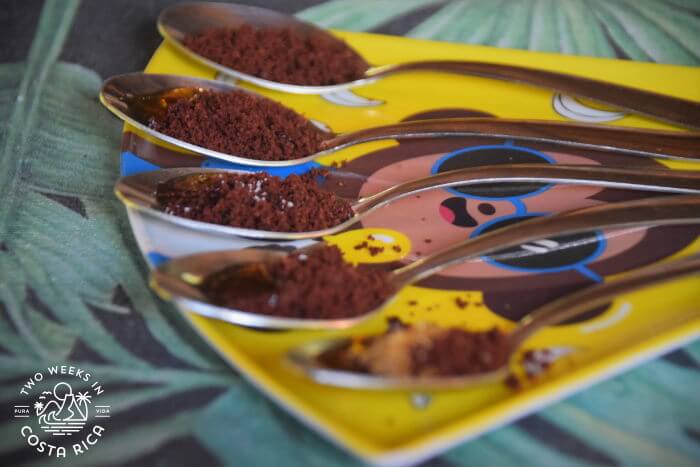
The Chocolate Cave
During the tour, we also got to visit the cave.
This is a stone structure that houses all the delicious chocolate that you can take home. They had different combinations with milk chocolate, 80% dark chocolate (with a little sugar), and even 100% pure dark chocolate (with no sugar added) for the serious chocolate lovers out there.
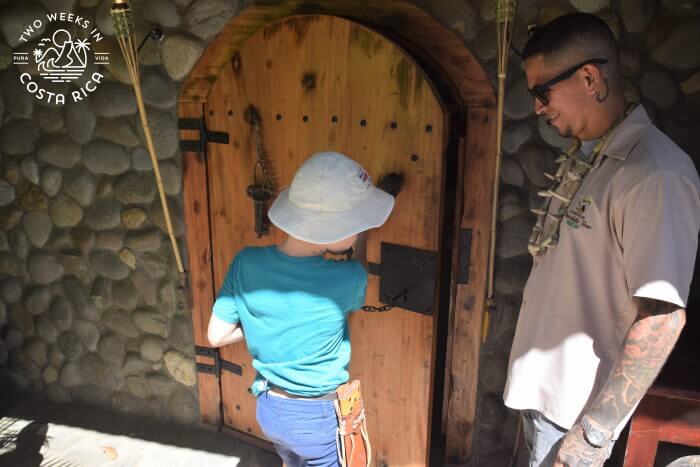
Trail and Monkeys
After the tour, you can check out the short trail behind the property. This goes around a natural lagoon that has caimen (small crocodile). We weren’t able to spot a caimen but did see a troop of white-faced monkeys and also some Scarlet Macaw parrots flying by. Though less common, spider monkeys also come through the property.
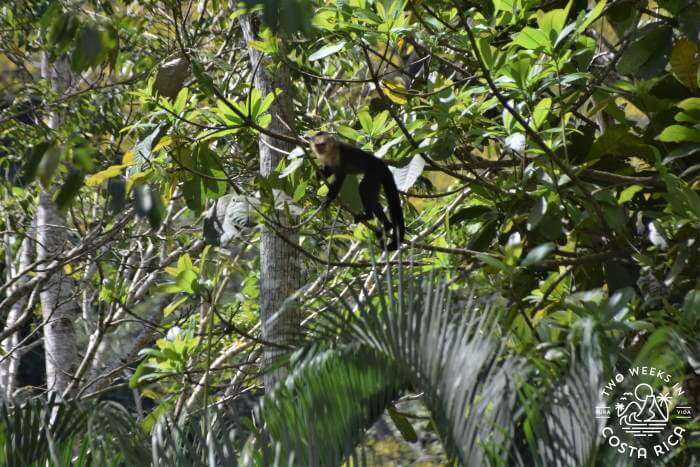
Planning Your Visit to La Mona Golosa Chocolate Farm
Tour Times
Tours are offered at 9:00 a.m., 10:00 a.m., 11:00 a.m., 1:00 p.m., and 2:00 p.m.
Advanced reservations are highly recommended so that they can arrange a guide for you.
Email them at dtourscostarica(at)gmail(dot)com or send a WhatsApp message to 506-8741-2607 for reservations.
Cost
Full Tour (recommended) – 1.5 hours
Adults – $45 per person. Children ages 5-12 – $35 per person. Children under 5 are free.
Breakfast or lunch is available for an additional cost if reserved in advance.
Self-guided Visit
$20 per person. This allows you to walk around the property and along the trail.
Buying Souvenirs
Although they have a credit card machine, internet can be spotty in this area so be sure to bring some cash if you want to take home some chocolate.
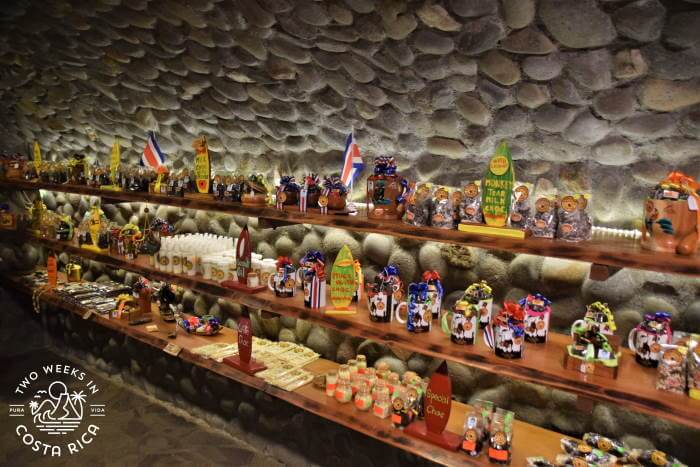
Transportation
If you don’t have a rental car, transportation can be arranged for $10 per person.
Directions to La Mona Golosa Chocolate Farm
The farm is in the town of Montelimar de Turrubares about 13 km (8 miles) off Highway 34.
From Jaco, head south along the coastal highway. A few miles after Playa Hermosa, you’ll pass a village with some houses and small grocery stores. Shortly after that, look for a turnoff on the left for a paved road. There will be signs for La Mona Golosa Chocolate Farm, Ocean Ranch Park, and Royal Butterflies.
This road is paved at times and dirt at others but is in good condition (no need for a 4×4 vehicle). Follow the curvy, narrow road along the river through the town of Mata Platano. In about 15-20 minutes, you will come to the entrance for La Mona Golosa. This is marked with a giant cacao pod statue and a big sign.
Here is a map with driving directions from Jaco.
GPS coordinates: 9°37’17.8″N – 84°29’27.4″W
Conclusion
We have done many chocolate tours in Costa Rica and La Mona Golosa was one of our favorites. It has an authentic feel and does a great job teaching the intricate process of making chocolate. If you’re visiting the Jaco area or just passing by, it’s worth a stop.
Have a question about visiting La Mona Golosa Chocolate Farm? Ask us below.
Looking for more information to plan your trip to Costa Rica? Check out these posts:
Jaco Tours: Check out this list with some more of our favorite tours in the Jaco area.
El Penon de Guacalillo: Scenic Ocean Cliffs and Caves – This is another lesser-known activity in the Jaco area. It’s a great place to catch sunset!
Villa Vanilla Spice Farm: A Rainforest of Flavors Near Manuel Antonio – Villa Vanilla is a biodynamic farm that grows vanilla, cinnamon, and lots more spices. It’s another one of our favorites.
Jaco Restaurant Guide: Check out our picks for Jaco’s best restaurants.
